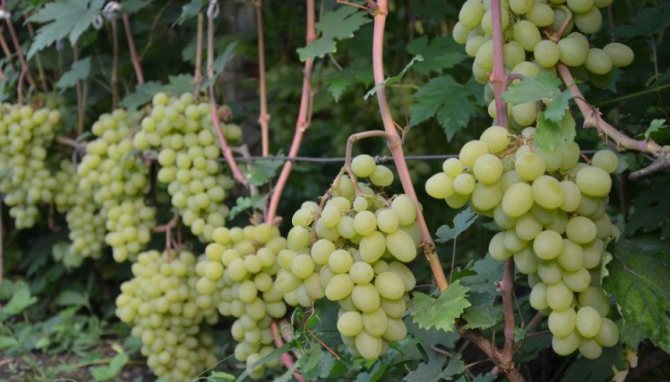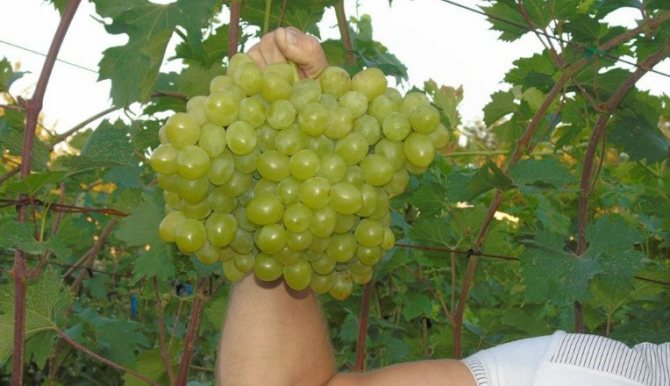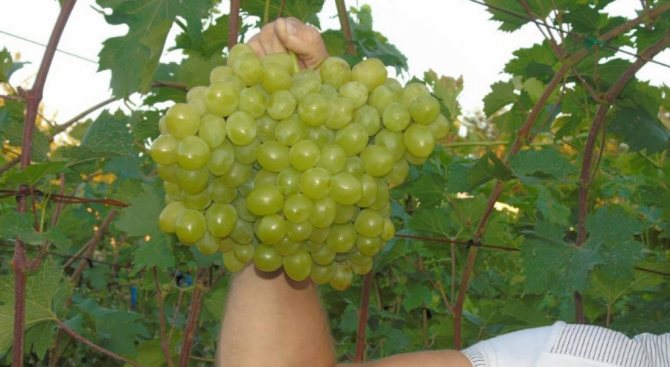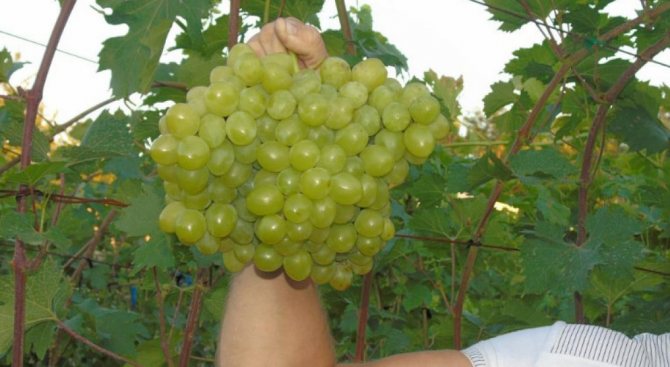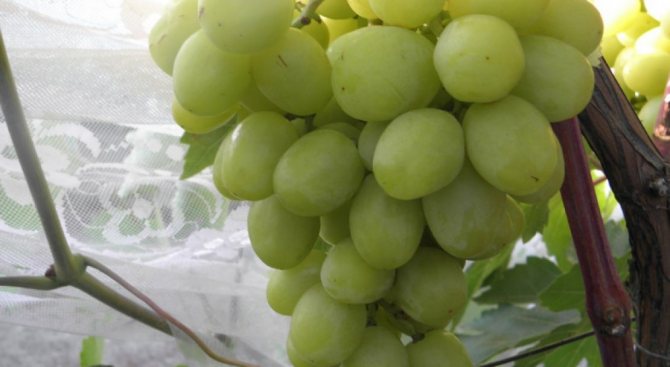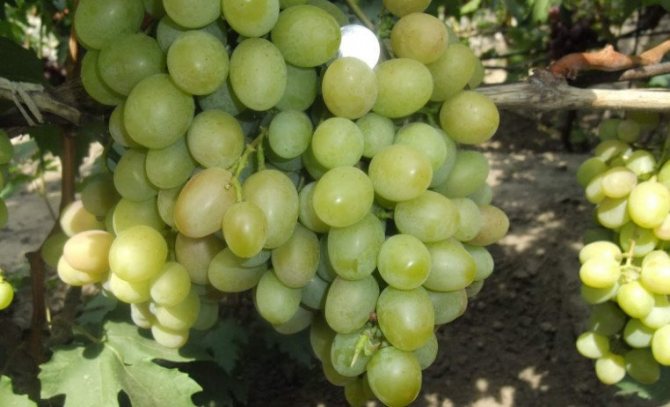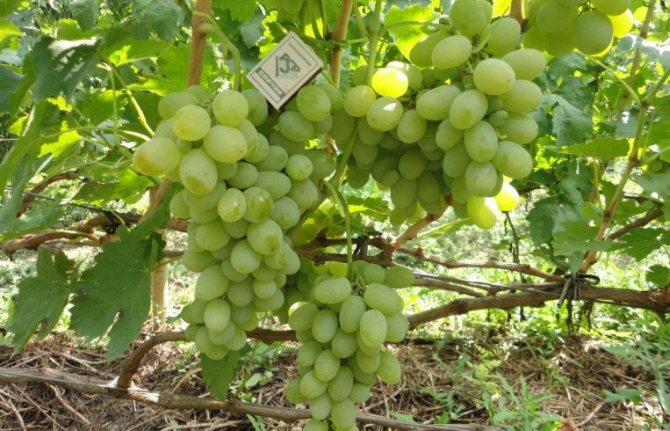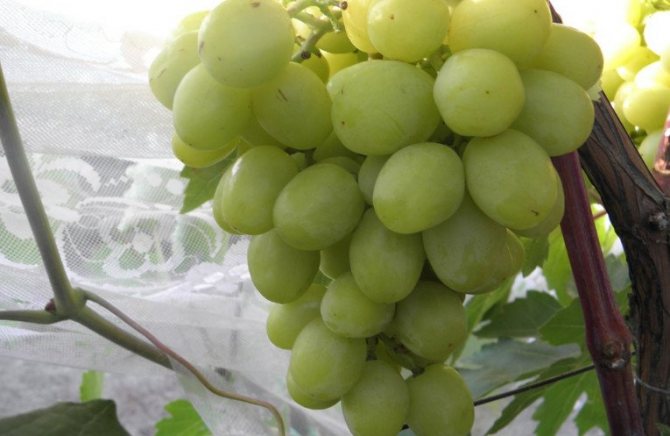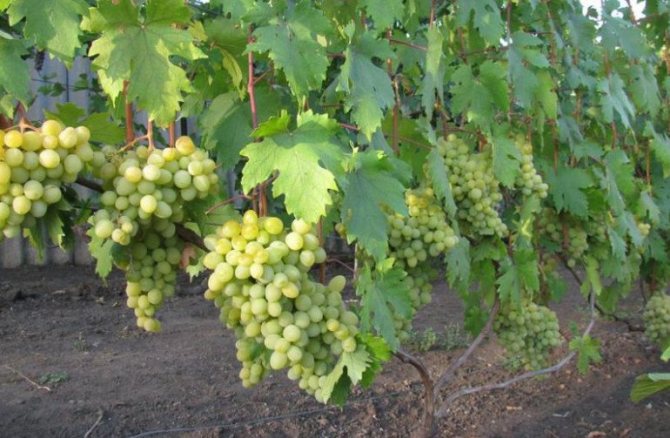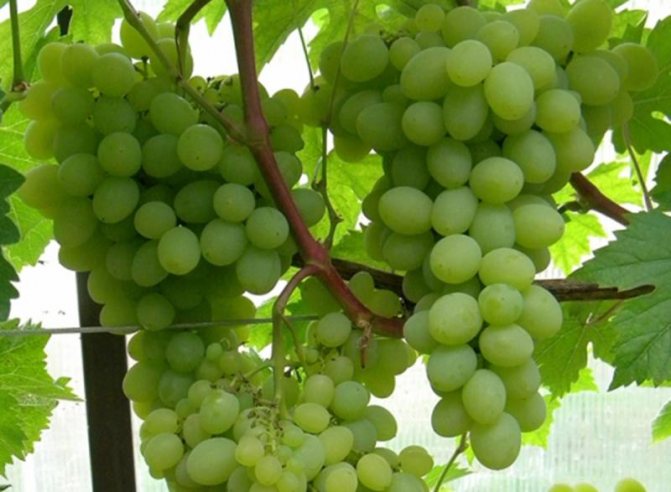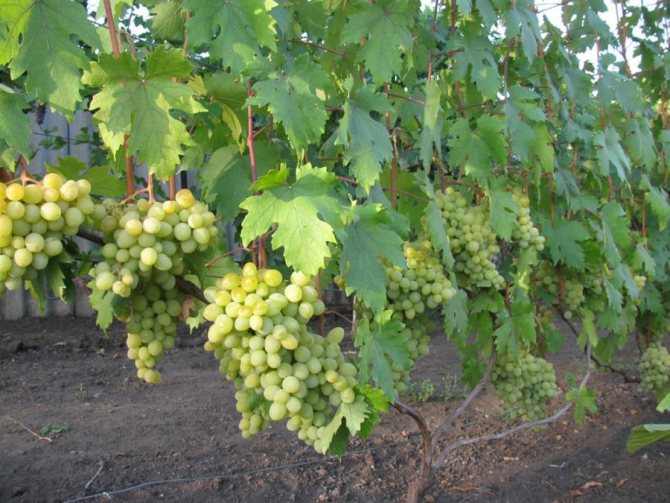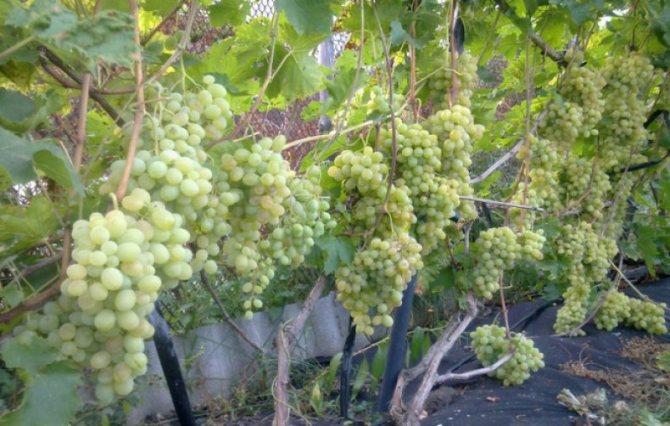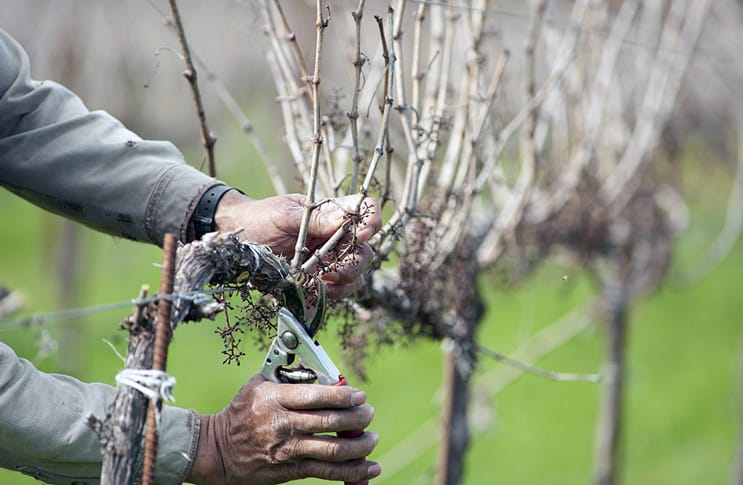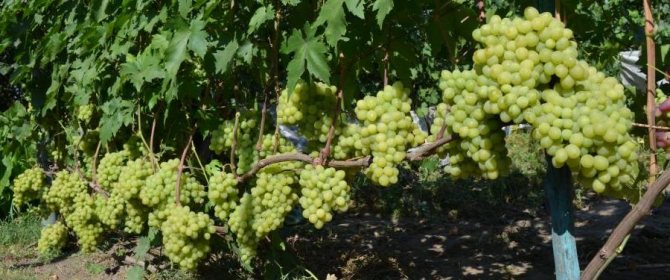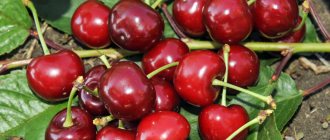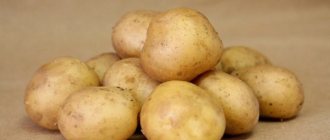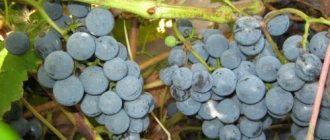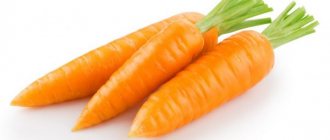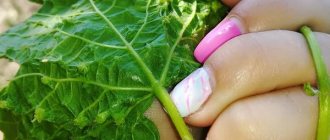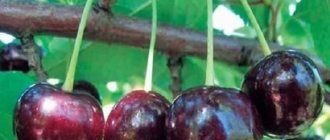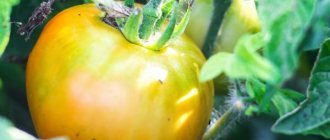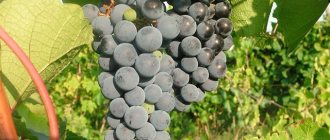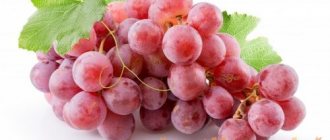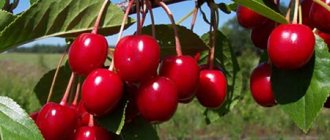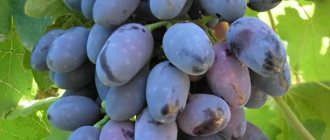.
Every grower wants to have only the best grape varieties on his site. Numerous trips to improve the properties of grapes lead to the emergence of excellent hybrid varieties, with high indicators of resistance to external influences, as well as with a qualitative and quantitative improvement in yield. These varieties include grapes breeder Vishnevetsky. Bred in central Ukraine, this grape, "inheriting" the best properties of three "parents" at once, turned out to be very appropriate and successful for cultivation in the northern regions.
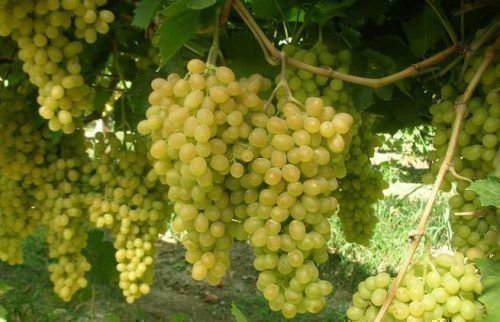
Bunches of Valek grapes on a bush
The Valek grape variety (this is what it received an official designation) has a number of advantages and quality characteristics.
The limited information coverage about this variety requires a more detailed consideration of important issues related to the properties and characteristics of Valek grapes, the peculiarities of choosing the area for planting it, important recommendations for reproduction, care and growth.
Valek grapes: variety description and reviews
Experienced winegrowers, wanting to get a good harvest of berries, closely follow the novelties of selection. Indeed, it is during the crossing of varieties that interesting hybrids are obtained, characterized by improved characteristics and taste.
Thanks to the development of hybrid varieties, grapes have long ceased to be exotic for the inhabitants of the middle lane and even the northern regions of our country. New varieties better tolerate difficult climatic conditions: dampness, cold. They ripen much earlier and at the same time are practically not inferior in their taste to more thermophilic counterparts.
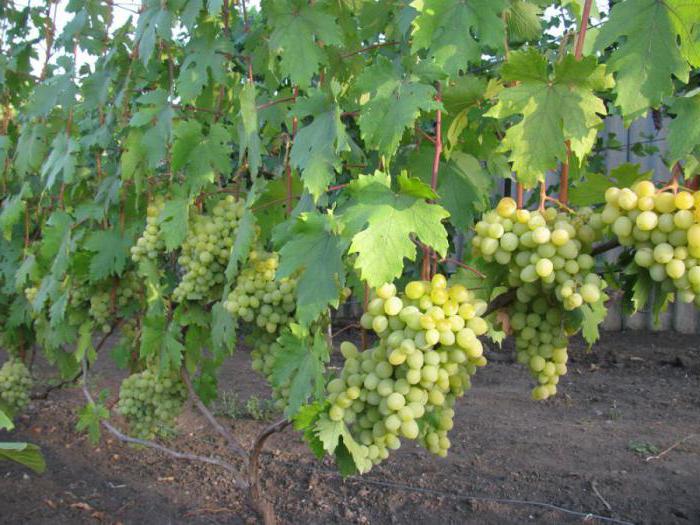

Today we will present you the Valek grape variety, a description of which is published in many gardening publications. It was bred by the famous Ukrainian amateur winegrower Nikolai Vishnevetsky. The novelty immediately pleased everyone who grows these amber berries not only in Ukraine. Very soon it was appreciated by Crimean gardeners. A little later, a successful development began to be grown in the southern regions of Russia, and over time it turned out that this hybrid shows excellent results in more northern regions.
Breeding history
The Valyok hybrid is based on such well-known and popular table varieties as Talisman (Kesha, FV-6-6), Zvezdny and Rizamat. This was done by an amateur breeder Vishnevetsky N.P. (Kirovograd region, Ukraine). This variety was bred in the north of Ukraine, but due to its qualities it has become popular in the temperate regions of Russia. This new hybrid is still being studied, but has already begun to be actively distributed among grape lovers.
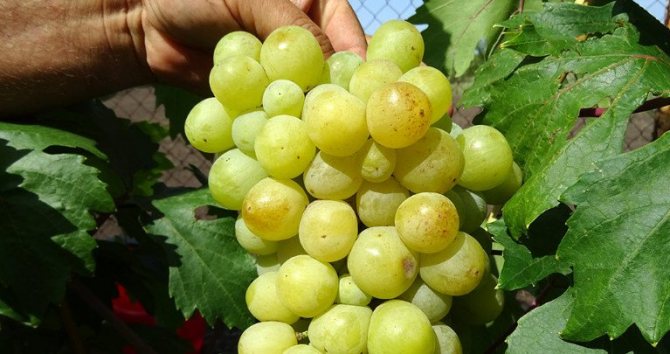

Valek grapes: variety description
Valek is considered a very early variety. Judge for yourself: fragrant, sweet berries on huge bunches are removed within 100-105 days from the moment the leaves bloom. This hybrid is famous for its high fruiting rates, which are explained by the presence of bisexual flowers. They bloom for ten days. In this regard, cross-pollination occurs in full.
Valek grapes delight the owners of these bushes with regular and rich harvests. In addition, mature plants give excellent vine growth, which matures during the summer. The vines are powerful but flexible.Shoots ripen amicably, each of which gives two or three clusters. Shoots are located almost along the entire length of a powerful vine.
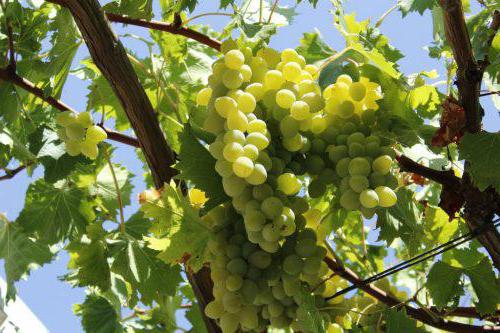

Leaves are medium in size, colored deep green. Their lower surface is slightly pubescent.
The Valek grape variety has large clusters, the weight of which ranges from 1.5 to 2.5 kg, with a rather dense structure. The fruits are oval, about three centimeters long and about two centimeters wide. Each berry weighs about 15 grams, but with good care and favorable climatic conditions, their weight can reach thirty grams. They are painted in a beautiful amber color, shimmer beautifully in the sun.
The Valek grape, the photo of which you can see in this article, belongs to table varieties. In terms of taste, it is recognized as one of the leaders in this group. The berries have a sweetish taste and a delicate nutmeg and pear aroma. The pulp is very juicy, the sugar content is 17-18%. The rind is quite thin, but strong, not felt when chewed. Subject to the rules of agricultural technology, about thirty kilograms of berries are removed from one bush.
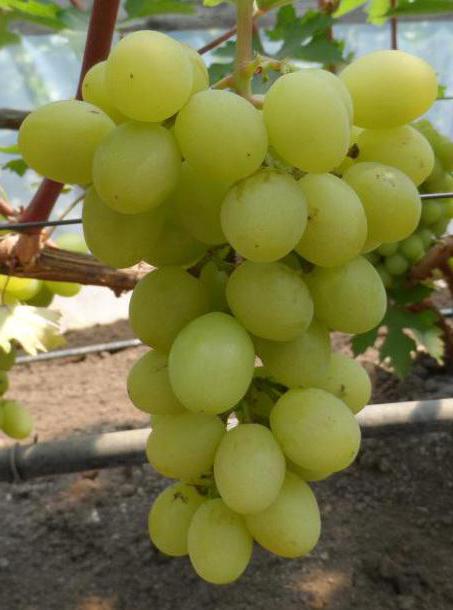

Fruit
Valek grapes have the following characteristics:
- The bunches are distinguished by their high density, large size and large weight (1.5 - 2 kg). It is noted that the older the grape bush, the more weighty the bunches are. This grape adds weight to its harvest every year.
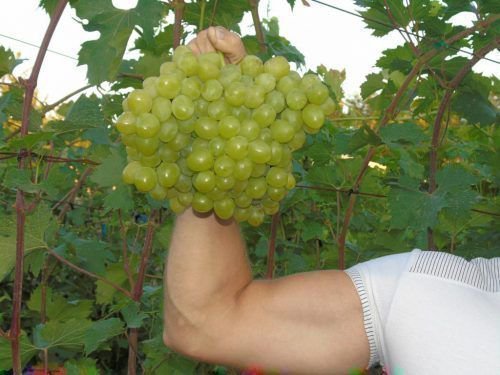

The bunches of Valek grapes are very large
- The berries have a regular, beautiful round / oval shape, about 3 x 2.8 cm in size. The weight of the berry is about 15 grams.
- The fruits are fleshy, yellow in color. The bright yellow color of the berries can brown when exposed to the sun. Experienced growers determine the degree of ripeness by the appearance of this shade on the fruit. If it appears, the berry is ready to be picked and eaten.
- The taste is full-bodied with hints of nutmeg and pear. Taste characteristics can be described as a sweet pear with pleasant notes of nutmeg.
- High degree of transportability, low probability of cracking.
- Long shelf life does not affect the appearance and taste of the berries.
- The peel is not inferior in taste to the pulp. Easy to chew.
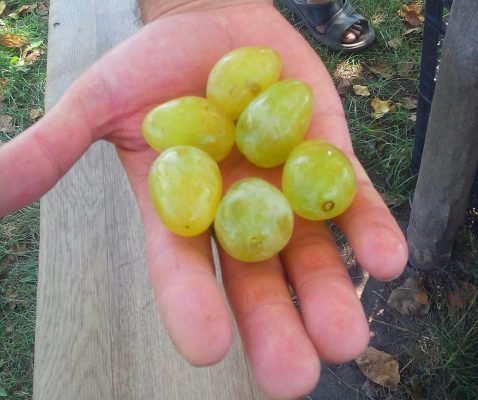

Valek berry is large and juicy
Bushes require regular and correct pruning of the vines to prevent peas. If these conditions are violated, the size of the berries decreases and the taste deteriorates (a sour taste appears). So you should not allow the development of even two bunches on one vine.
The berry of this white table grape is intended to be eaten fresh.
The density of the berries in the bunches is often one of the main disadvantages of this grape variety. For this reason, Valek is not in demand and popularity among wholesale buyers. However, in practice, the density does not lead to crushing, cracking and subsequent spoilage of the berries.
Selection of seedlings
Experienced winegrowers argue that Valek is best bred with the help of own-rooted cuttings. If you buy grafted seedlings, then, it is likely that their taste will be slightly lower than that of their own rooted ones. To choose the right seedlings of Valek grapes, you need to pay attention to the fact that the root system must be healthy and well developed. They should not have scratches, damage, as well as cracks in the bark, spots, which usually indicate the development of a fungal disease.
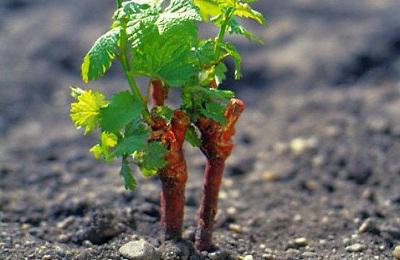

It is advisable to purchase seedlings in containers. They take root better after planting in open ground.
Landing
When growing Valyok grapes, it is enough to follow the basic rules of growing crops and know some of the characteristics of the variety that will require additional attention from the gardener.
The extremely tall Valka bush needs good support.Trellises will become an ideal support, they will not only support the bush, but also contribute, thanks to the even distribution of bunches, good ventilation inside the bush and the influx of sunlight.
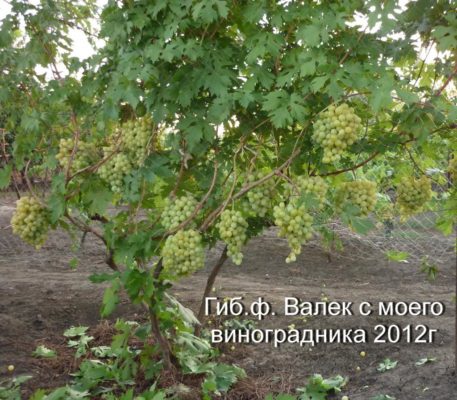

Valyok is extremely tall and productive and needs good support
Planting with a self-rooted bush is preferable, but many gardeners say that when planting with a cuttings, there are also no problems. It is possible to grow on a stock, but this method of growing for a given variety does not guarantee the preservation of its properties.
One of the features of the variety, which some gardeners consider a disadvantage, is the high density of the bunch. The bunch can be thinned out at the initial stage of its formation. But most winegrowers argue that the density still does not affect the quality and condition of the berries: they do not crack, do not peas, do not rot, and remain just as tasty.
The variety is affected by wasps, so it is necessary to take care of protecting the grapes from these insects: set traps, cover the bunches with a protective net, destroy wasp nests near the planting.
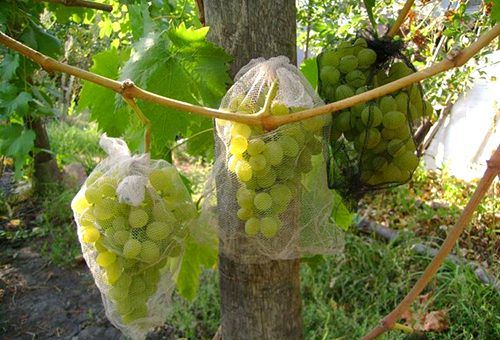

You can protect ripe bunches from wasps using special mesh bags
Valyok loves light soils. It is recommended to plant it on light loam with a small amount of black soil. Some gardeners, in reviews of the variety, note that Valyok feels good on sandy soils.
The roll does not require long shaping, although, as already mentioned, with the accumulation of perennial vines, the yield increases. You can trim it into 6-8 eyes. Bunches are tied from the bottom knots (2 for each shoot).
Among the variety of grape varieties, it is not easy to choose the one that will really live up to expectations and will settle in the garden for years to come. Valyok can become such a variety - very early, fruitful, disease-resistant, frost-resistant, with excellent original taste - it is a worthy contender for the title of an ideal variety.
The hybrid form of Valyok grapes was bred by the Ukrainian amateur breeder Nikolai Pavlovich Vishnevetsky.
Having tested many varieties and forms on his site, he never found the ideal grape - high-yielding, with a dense, tasty berry and a long shelf life, moreover, growing well in the climatic conditions of the Kirovograd region (this is where the vineyard and the experimental site of the breeder are located).
Nikolai Pavlovich bred such grapes himself. Today, 16 hybrid forms of grapes bred by Nikolai Pavlovich are described, most of them are well known and loved by winegrowers. A worthy place among the hybrid forms of Vishnevetsky is occupied by Valyok - white table grapes with a very early ripening period (about 100 days), having a pleasant fruit-nutmeg taste.
Valka berries are oval, large, dense, turn golden yellow when fully ripe
The bush of this hybrid form has great vigor. The author of the variety recommends planting Valyok with his own rooted bush. The vine ripens over the summer almost to its entire length. Full fruiting can be expected in the second or third year. Having accumulated a perennial vine, the bush bears fruit more and better.
The plant has bisexual flowers, flowering lasts up to 10 days, pollination occurs wonderfully even during rains. Moreover, Valyok is a good pollinator for other nearby growing forms and varieties of grapes.
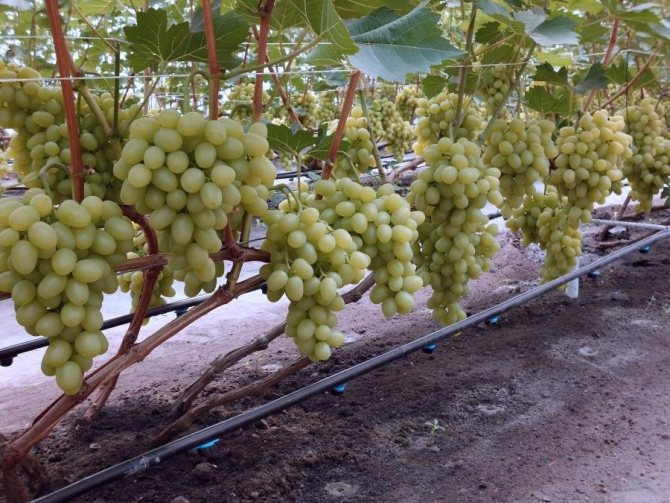

The bunches are large, on average 1.2–1.5 kg, can reach 2.5 kg, and are very dense. The berries are also large, oval (inside the bunch, due to the high density, the berries may have a different shape), fleshy, with a soft skin that can be eaten well.
A distinctive feature is a pleasant nutmeg flavor and pear aftertaste. The color of the berries is from green to golden yellow when fully ripe.
Ripe berries can hang on the bush for a very long time without cracking or falling off, but you have to take care of insect protection - Valk berries are extremely attractive to wasps.
Valyok is resistant to mildew, oidium and gray mold.
The yield of the Valyok variety is high, the clusters are large and dense, they can stay on the bush for a long time
The frost resistance of the hybrid form is -24оС. In cold regions, shelter will be required for the winter. Many gardeners practice growing this form in a greenhouse, but with competent agricultural technology, Valyok grows well in the open field, even in colder regions than the Kirovograd region of Ukraine, where the variety was bred and tested.
In cold regions, Valyok can be grown in a greenhouse, so the likelihood of full ripening of the berries increases significantly
It is better to choose grapes of the Valek variety for breeding with a rooted cuttings. A grafted stalk of this variety is inferior to its own rooted crop in terms of taste. Before buying a seedling, it is important to check that it does not have:
- damage and torn scratches;
- clear signs of drying;
- various spots that may indicate fungal diseases.
Description of Valek grape seedling suitable for planting:
- the stalk has 2-3 roots;
- a shoot with a height of 40-50 cm is developed on the seedling.
Advice: choose seedlings of grapes in a container, so they take root better in the open field. It is recommended to plant shoots of the Valek variety in an unshaded place on a hill, protected from the wind. Strong gusts of wind can damage the vine.
Cuttings are planted in the ground in the autumn-spring period. When planting in the spring, it is important to provide young shoots with moisture, and planting in the fall requires special care in the further shelter of young, immature cuttings.
The plant has a strong root system and the ability to grow over time. Considering this, it is necessary to plant cuttings at a three-meter distance from each other in order to ensure adequate nutrition of the roots and a sufficient amount of sunlight.
Grapes do not tolerate wet soil in lowlands, shady and swampy places. This should be taken into account when choosing a landing site. Best of all "Valek" grows on light loam with a small amount of black soil.
Before planting a seedling, the pit should be fed with special fertilizers, which will provide the young plant with an abundance of nutrients during the growth period. Watering the grapes is provided no more than three times a year. In a particularly dry year, you can water four times.
As already mentioned, Valek grapes are best grown on a self-rooted cuttings. When purchasing planting material, pay attention that there are no scratches and other damage on the handle, there are no signs of drying out, there are no spots that can be a sign of fungal diseases.
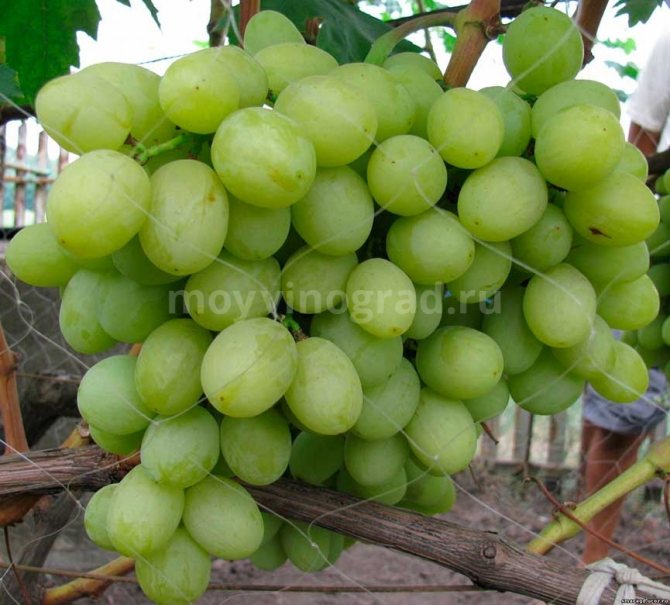

A stalk suitable for planting has 2-3 healthy roots, a young shoot is 40-50 centimeters long. Bushes can be planted both in spring and in autumn. A well-lit place without drafts is chosen for planting. It is important to think over the drainage system in advance, since stagnant water negatively affects the development of the plant and can lead to decay of the root system.
In order for the valek grapes to give a good full-fledged harvest and the plant to be healthy and strong, certain conditions must be observed when planting:
- Planting grape cuttings should only be in places well-lit by the sun, where there is no shade from other plants.
- This variety does not take root well in excessively moist and swampy areas of the soil. In such conditions, grapes will not grow.
- For good growth and high yields, grapes are best planted on loamy soil with the addition of black soil.
- Valyok grapes do not tolerate cold winds and strong drafts.It is very good to plant it near the wall of a building or under a high solid fence.
For planting grapes, it is recommended to choose cuttings that have already formed their own root system. This method has the best effect on the taste of the fruit. In order for the cuttings to develop well and subsequently take root in the soil, the following features must be taken into account when choosing grape seedlings:
- When buying a seedling, you need to make sure that it does not have any external defects, damage and scratches.
- It is not recommended to use seedlings that have visible spots of unusual colors. This could be a sign that the plant has a fungal infection.
- You should not purchase dried cuttings.
- It is best to give preference to the cuttings planted in a special container. Such seedlings take root in the open field much better in the future.
- A healthy, full-fledged seedling should have several developed roots.
- The length of the shoot should be at least 40-50 cm.
Read more: Quail incubator: DIY making
It is best to plant such a seedling in the middle of autumn or at the very end of winter. If the plant is properly cared for, it can bring a good full harvest as early as the third year after planting. To plant a plant in open ground, it is necessary to prepare a hole for the seedling.
The depth of the planting pit should be from 50 to 70 cm. The soil taken from the top removed layer is laid on the bottom. For better growth and development, grapes need to be fed with organic fertilizers. Put a layer of compost on top of the soil and sprinkle it on top with another layer of earth. In this state, the pit should remain for a week, after which a seedling can be planted in it.
The seedling should be placed in the ground, keeping the roots in an earthen coma. The plant needs careful watering. When planting in autumn, the roots must be protected from freezing.
Choosing a landing site
This is very important if you want large and stable yields. The site must meet the following requirements:
- Good illumination. This indicator affects the rapid growth of the bush and the ripening of berries. It is advisable to choose a site for planting away from tall buildings, bushes or buildings.
- Lack of drafts. Piercing through winds harm self-pollination. This will lead to a decrease in yield.
- Landing on a hill. It is advisable to plant bushes on a hill, although this is an optional condition. It is due to the fact that cool air often accumulates in the lowlands. It is very harmful to grape bushes, especially young ones.
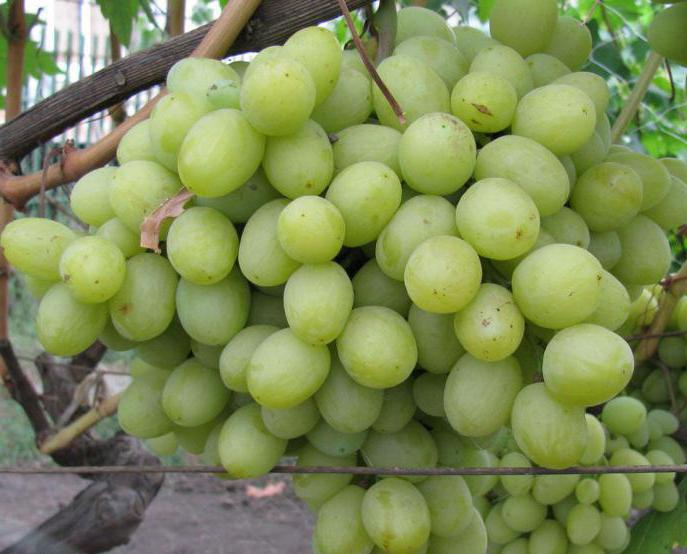

Vine formation
The Valyok grape vine requires special attention. For the plant to grow well and produce a good harvest, the vine must be shaped properly. Of everything exists several ways to properly form the vine:
- Breaking off. In order to provide the sprouts with a sufficient amount of moisture and nutrients, it is necessary to remove damaged and dried elements in a timely manner. Removal of shoots is allowed only in cases where there are antennae and formed inflorescences, but before they harden.
- Topping. This procedure is carried out before the inflorescences appear on the grapes. It is carried out in order to prevent excessive growth in height. For this purpose, the green shoot is carefully broken off in the upper part of the plant and stepsons.
- Thinning of the leaves is done with the aim of faster ripening of the berries. Thinning can be carried out several weeks before the berries are fully ripe. No more than 5 leaves can be removed from each bunch. The largest leaves are usually removed. It is very important not to damage the brushes when thinning.
- In the autumn, it is necessary to prune the vine - at this time it grows as much as possible.
What should be the soil?
The Valek grape is undemanding to soils, but in practice it has been noticed that it develops and bears fruit better on light loams with an admixture of chernozem. Groundwater should not come too close. The optimum level of their occurrence is 2.5 m. Soil fertility is achieved with the help of fertilizers.
The choice of Valek grape seedlings is undoubtedly very important, but their competent planting is no less important. Saplings are planted in open ground in spring or autumn. Planting in spring obliges winegrowers to provide the necessary amount of moisture for young plants, and in autumn, care must be taken to protect the seedlings as much as possible and carefully cover them.
Valek grapes are planted in pre-prepared pits 70 cm deep. Consider a drainage system in advance, which will provide moisture to the plant's root system. Before placing the young bushes, the prepared pits are filled with a mixture of garden soil and compost, and then they are filled with water. Now it's time to place the seedlings in the holes, placing them in the center of the hole.
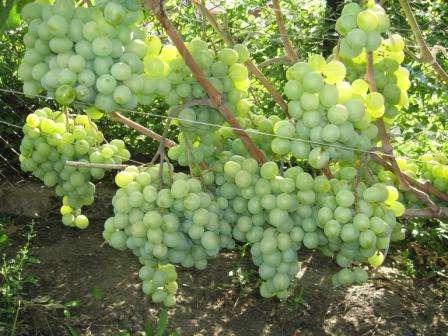

Taking care of grapes
Variety Valek does not require special care in comparison with other varieties. As with all fruit crops, it is necessary to regularly weed weeds, loosen the soil and water the shoots.
It is recommended to water the grapes during the periods of bud development, during flowering and the formation of bunches.
Important: every time you water, remember to cover the soil under the grapes with moss or sawdust. In the professional language of gardeners, this process is called mulching. Special attention should be paid to the procedures for breaking, pinching and pruning the vine.
- Breaking off. Dry or diseased vine shoots must be removed as soon as the inflorescences and tendrils are formed. Also stepchildren are subject to timely breaking off.
- Topping. With the help of the procedure, the growth of vines in height is limited. Experts recommend pinching the shoots before flowering to ensure an increased supply of nutrients to the inflorescences.
- Pruning. The grapes need pruning of shoots and vines. Large leaves are removed, covering the clusters from the sun's rays. Pruning of the bush itself is carried out in the fall and is intended to limit the excessive growth of the vine.
Important: growers do not recommend cutting off all the leaves around the bunch, so as not to harm the bush. It is enough to remove 3-5 of the largest ones.
Caution, grape diseases Despite the resistance of the Valek variety to various pathogens, it should be protected from the most dangerous diseases of this grape species: mildew and powdery mildew.
- Mildew. High humidity and heavy rains in the summer provoke the multiplication of fungal spores. bores, falling on the leaves, grow, move to shoots, buds and, as a result, can cover the entire bush. The main symptoms of mildew are clear oil spots on the outside of the leaves and white bloom on the inside. The main condition for defeating the disease is to ensure the ventilation of the vine: timely removal of stepsons, pruning of foliage. Solutions based on copper sulfate and slaked lime help to cope with mildew. The most commonly used mixture is Bordeaux, which experienced winegrowers advise to purchase in stores. A self-prepared solution with a deviation in the recipe can burn the grape leaves.
- Oidium Fungal disease covers leaves and shoots of Valek grapes with an ash-colored bloom. Berries on the affected bunches crack and get wet. To avoid spreading the disease to the entire vineyard, diseased shoots are removed. Dusting with finely ground sulfur effectively helps from powdery mildew.
Important: when watering, experts strongly do not recommend wetting the leaves and shoots of grapes. Humidity creates favorable conditions for the reproduction of spores. It is important for a novice wine grower to master 3 basic principles that will protect the crop from diseases:
- drainage of excess moisture from the soil;
- eradication of weeds that are carriers of pathogens;
- prevention of infection by spraying with drugs (topaz, quadris, chorus and others).
Caring for Valek grapes is a little easier than for the rest and does not require much effort. Like all fruiting plants, it requires careful weeding from weeds, loosening the soil near the roots, as well as regular watering, especially in the hot season. After each watering, do not forget to sprinkle the soil under the grapes with sawdust or plant moss.
If you want to feed your grapes, then this should be done in the fall. The fertilizer can be wood ash or manure. For one square meter, you will need about 100 grams of ash, about 6-7 kilos of manure. You can also resort to spraying the plant with drugs, which can be done three times during the ripening period of the fruit.
At a time when the cold season comes, you should take care that the grapes do not freeze. To do this, you just need to cover it, and after the frost has receded, remove the insulating material.
Breaking the vine
In order for the sprouts to be enriched with nutrients and liquid, dry and damaged areas should be broken off. Shoots can be removed only if there are already formed antennae and inflorescences.
Pruning
This procedure should be carried out in the autumn, when the vine grows the most. It is necessary to cut off very large leaves that interfere with the development of the bunch of grapes with its fruits. But the main thing is not to overdo it, otherwise you can damage the bunch. It is best to cut off a few leaves near the bunch itself. This is done so that the rays of the sun can hit the ripening bunches.
Topping
This procedure should be carried out before the inflorescences appear on the grapes. It is carried out so that the plant does not stretch in height.
Do you need pruning?
Valek grapes need not only pruning, but also pinching and breaking off. Break off, as a rule, the shoot, which is sick or withered. This must be done after the inflorescences and antennae have passed the stage of formation. In addition, it is necessary to break off the stepsons in a timely manner.
Pinching Valek grapes is necessary in order to limit the growth of the plant in height. To provide the bushes with adequate nutrition, this process is carried out before flowering. Experienced growers know that pruning shoots and vines is a must for all varieties. Remove the largest leaves that cover the bunches from the sun's rays. It is not necessary to remove all of them, as this can damage the bush. It is recommended to trim no more than five of the largest leaves.
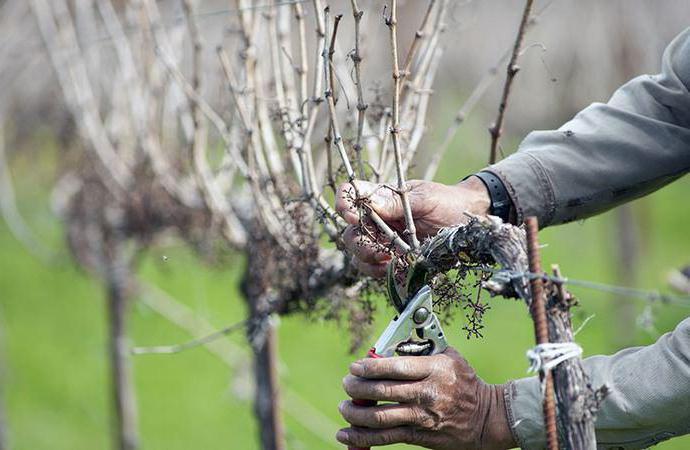

Full pruning is carried out in the fall. This is necessary in order to prevent overgrowth of the vine.
Pest control and disease prevention
The Valek variety is quite disease resistant. The plant can be subject to diseases such as mildew, oidium, rot. In order to prevent the appearance of such problems, it is necessary to carry out simple prevention:
- control soil moisture;
- remove weeds near grapes;
- periodically spray with fungicidal agents, at least three times during ripening;
- apply the necessary fertilizers on time.
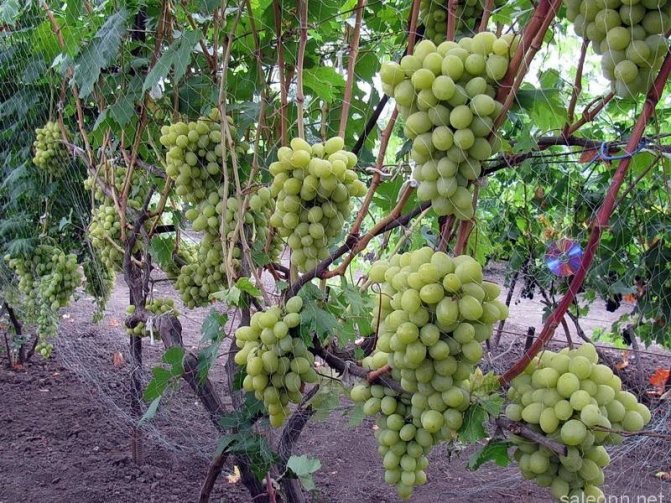

The grapes are covered from birds with special nets.
The sweet variety is very fond of wasps, which flock to the fruits. You can protect the berries with special nets.
Important! It is recommended to arrange insect baits, remove their nests.
Valek grapes are very popular among winegrowers. The culture pleases with its productivity, rapid ripening and unpretentiousness. Due to its frost resistance, the variety can be grown even in not very favorable conditions.
Diseases and pests
We mentioned that this hybrid is resistant to many diseases that affect other grape varieties.But this, of course, does not mean that this variety is invulnerable, therefore, care must be taken to protect the bushes from diseases such as oidium and mildew. They can seriously harm the plant and even lead to its death.
Read also: Varieties of beans: varieties, taste, distinctive features
High humidity and rainy weather for a long time are favorable conditions for the development of mildew. At such a time, spores are actively developing, which first fall on the leaves, and then spread to the entire bush. If you notice oily transparent spots on the outside of the leaves and white bloom on the inside of the plate, this means that the plant has been infected with mildew.
It can only be overcome by creating good ventilation for the vine. For this, the bush is cut off and the stepsons are removed. After that, the plant is treated with solutions based on copper sulfate or slaked lime. Bordeaux mixture shows good results in the fight against this disease. This drug can be bought at any specialty store.
Oidium is quite easy to identify by the ashy bloom that appears on the shoots and leaves. It occurs due to the development of a fungus. Fruits that grow on bunches affected by powdery mildew get wet and burst. To defeat the disease, it is necessary to spray sulfur, ground to a powdery state. In order to prevent the spread of the disease in the vineyard, diseased shoots are promptly removed and burned.
Diseases to which the variety is susceptible
Subject to agricultural technology, the vine rarely suffers from fungal pathologies. However, prevention is still needed.
Oidium
Rarely, but it is still possible to become infected with the fungal disease powdery mildew. The leaves are covered with a gray bloom, the berries crack on the bushes and get wet. In case of damage, all damaged leaves and fruits are urgently removed, and the bush is treated with sulfur-based preparations.
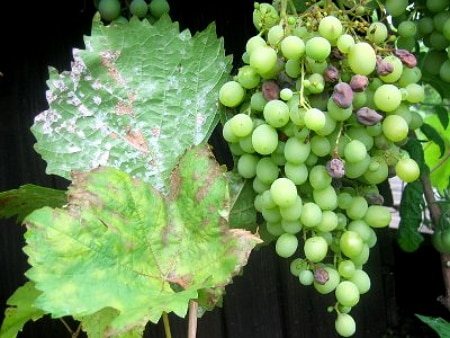

Mildew
In a cold summer with a lot of precipitation, a mildew fungal disease develops; it is determined by oily spots on the leaves. For the treatment of Valek bushes, copper-containing preparations are used, for example, a solution of Bordeaux liquid.
Valek grapes: reviews of gardeners
Most of the positive reviews about this variety come from the central and northern regions of our country. Apparently, southerners are spoiled by a huge number of varieties that can be grown on their lands.
Growers note the plant's high frost resistance. In addition, it is important that this variety is not affected by gray mold. And, of course, the fact that it gives a large and stable harvest. The berries tolerate transportation well, while maintaining their presentation.
The only drawback of this hybrid is that the berries infect the bees, which requires the use of mesh bags and traps.
Diseases
In general, this is a fairly healthy hybrid table grape, but sometimes prone to infection with certain fungal diseases:
Oidium
This disease infects grapes with a fungus. The leaves of Valyok grapes become dull, and a dirty gray bloom appears on their surface, a consequence of the spread of the fungus. The infection affects not only the vine, but also the berries, which become soft and covered with cracks. Below is an example of mildew infection. In order to avoid the spread of this disease to the whole plant, the affected areas should be cut off. A sulfur solution, which will be finely ground, will effectively cope with this ailment. It is also recommended not to expose the leaves to excessive moisture so that the fungus does not develop.
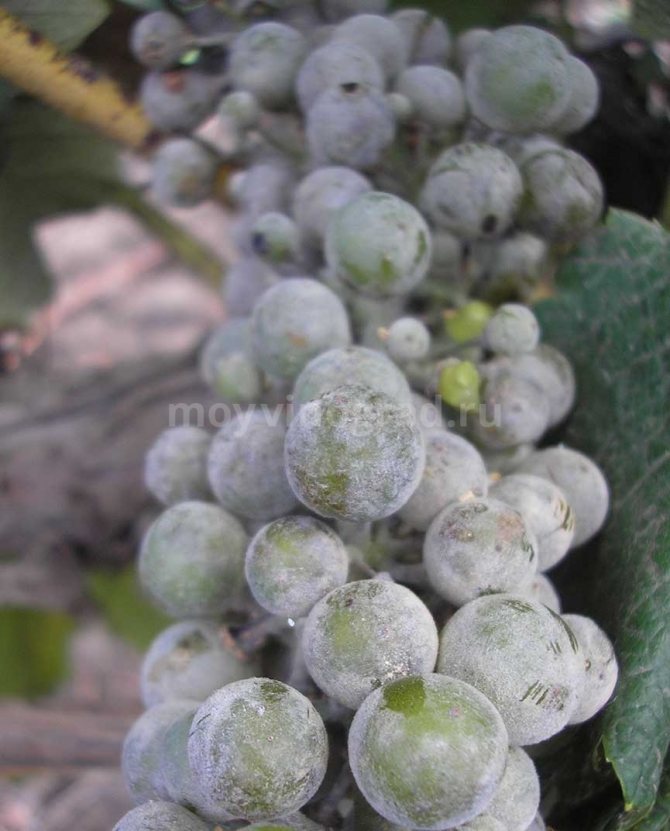

Mildew
Another fungal disease that this grape variety is susceptible to. When the fungus spreads, a white coating appears, the affected leaves should be removed to prevent further spread.In the fight against this fungal infection, copper sulfate and slaked lime will help.
Detailed description of Valek grapes
Every grower wants to have only the best grape varieties on his site. Numerous trips to improve the properties of grapes lead to the emergence of excellent hybrid varieties, with high indicators of resistance to external influences, as well as with a qualitative and quantitative improvement in yield. These varieties include grapes breeder Vishnevetsky. Bred in central Ukraine, this grape, "inheriting" the best properties of three "parents" at once, turned out to be very appropriate and successful for cultivation in the northern regions.
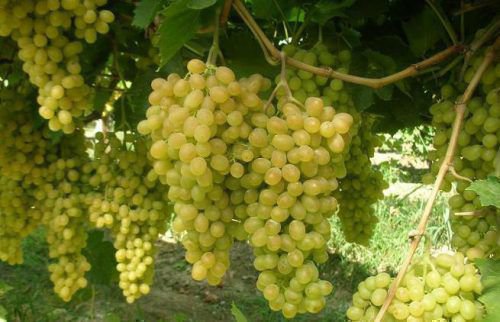

Bunches of Valek grapes on a bush
The Valek grape variety (this is what it received the official designation) has a number of advantages and quality characteristics.
The limited information coverage about this variety requires a more detailed consideration of important issues related to the properties and characteristics of Valek grapes, the features of the choice for planting the area, important recommendations for reproduction, care and growth.
Advantages and disadvantages of the variety
The positive characteristics of the Valek variety include:
- large-fruited;
- unpretentiousness;
- high yield;
- excellent consumer qualities;
- good keeping quality of fruits;
- the transportability of the crop;
- frost resistance;
- drought resistance;
- increased immunity.
Among the minuses of the hybrid are:
- vigor;
- the need for normalization.
- High frost resistance. The vine can withstand a drop in temperature to 23-25 C ° below zero. Despite this, experienced growers recommend covering the grapes for the winter.
- Resistant to diseases of fungal origin, not affected by gray rot.
- Good yield, a three-year-old plant produces a crop of 20-22 kilograms.
- Grapes "Valek" tolerate transportation well, without losing their good presentation.
The berries of this variety are attacked by bees, so you need to set up traps or use protective bags.
- Weeding the soil regularly.
- Watering in the summer, carried out no more than 3 times, and if the weather is too hot - 4 times. Moisture is the basis for the growth of any plant. It is important to water the bush before flowering, as well as at the time of the formation of brushes. Each watering is recommended to be accompanied by soil mulching, for which you can use moss or sawdust.
- Breaking off shoots is necessary to get rid of bad, sick, dry branches that interfere with the normal flow of water and nutrients to fruitful healthy shoots. It is recommended to break off the shoots after the formation of antennae and inflorescences, but before their hardening and woodiness at the base. The procedure is required to start from the base of the bush with a gradual advance to the sleeves.
- Pinching (the essence of which is to get rid of the green shoot from the upper part) and breaking off the stepsons, which causes the supply of the required amount of nutrients and water to healthy sprouts. These procedures, which help to avoid abnormal development and slow growth of the plant, are carried out a couple of days before flowering in order to avoid strong overgrowth of the bush.
- Thinning of leaves that lie on the surface of the bunches and cover them from the sun's rays. This will cause the grapes to ripen quickly and increase the sugar level in it. This procedure is required to be performed several weeks before the ripening of the grape clusters. In order not to harm the plant, it is recommended to remove 5 leaves (or less) near each bunch.
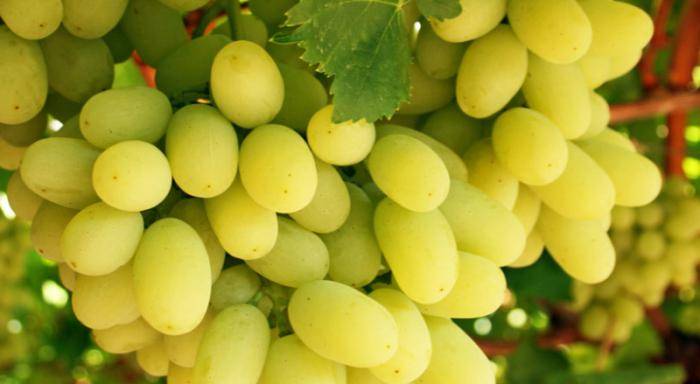

- Pruning is done in the fall, after the leaves have fallen off. This is required in order to avoid overgrowth of the bush and crushing the berries of the future harvest. No pruning is done in the first year after planting.
- Spraying is aimed at destroying pests and preventing various diseases.
- Ground dressing is carried out in the autumn.Fertilizer is applied as close as possible to the roots of the plant in a trench dug near the bush. The proportion in this case is as follows: 1 sq. meter covered with vines requires 6-8 kg of manure and 80-100 grams of wood ash.
On the eve of the winter period, the bushes must be covered, and at the end of the frost, the vine must be opened. This is best done in cloudy weather before sunrise or after sunset.
Although Valek is rarely exposed to fungal diseases, it is still better to treat the surface of the vine with special chemical solutions.
General characteristics of the variety
Valek grape is a hybrid grape of complex selection, combining the features of the following varieties - Kesha 1, Zvezdny and Rizamat. For the first time, a successful crossing of these varieties was made by a breeder from Ukraine N.P. Vishnevetsky. For this reason, the variety itself is very often called the hybrid form of Vishnevetsky. The birthplace of grapes is the Kirovograd region.
Having absorbed the best properties of 3 varieties, Valek is a very high-quality and popular plant today in the plots of many winegrowers.
This variety has the following specific features:
- Very early ripening period. Yields a harvest in three and a half months. The crop can be harvested from mid-July. In the northern regions (relative to the historical homeland of this grape), the harvest dates are determined by the end of August. In the Rostov region, Valek ripens 5-7 days earlier than the Arcadia variety, which belongs to the best grapes in terms of early maturity.
- The variety is resistant to gray mold and autumn fungal diseases. Cases of lesions with gray rot are practically not recorded, they are isolated. The dangers include the negative impact of the wasps, which are very fond of Valek as a food source. Valek is not afraid of mildew or oidium.
- The preferred planting method is seedlings. Cuttings take root quickly and without problems, subject to the basic rules of planting and site selection.
- Good pollination, even during rainy periods. Refers to the bisexual type of plants. Bisexual, which is a guarantee of pollination, gives an almost absolute indicator of the formation of the ovary. Valek serves as an excellent pollinator for other grape varieties.
- The flowering period is up to 10 days.
Refers to high-yielding varieties. From a bush, you can collect 35-40 kg of fruits.
The plant itself and the fruits are quite resistant to transportation costs. Resistant to frost up to -24 degrees.
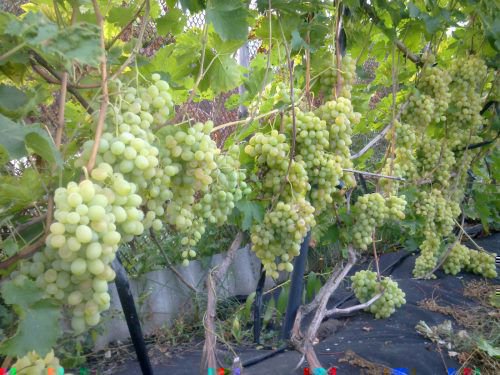

Valek grape bush grows strongly
The bushes are vigorous. They give a fairly large increase in young vines every season. Without control, the bush can grow, in a short time, quite strongly. A young vine ripens to its full length in the summer. Ripening of shoots in the first season after planting is quite good.
Testimonials
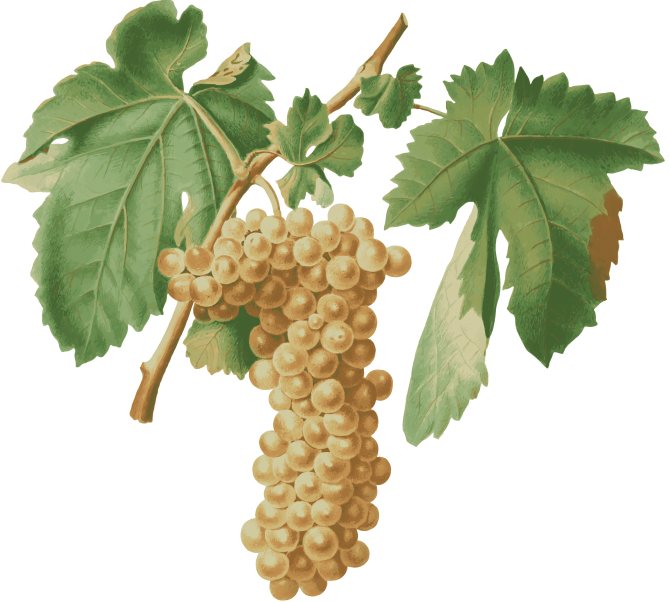

The brushes are very large, 1500-2.500 kg, with a beautiful large berry. The berry is fleshy with a pleasant nutmeg and pear flavor. Valek is loved by children and all other household members. Artyom, Donetsk region
Gray rot is not affected. Very resistant to fungal diseases. Transportable and very productive. Andrey, Vinnytsia
Valek has a high yield, but the clusters are dense - unfortunately this is a big drawback of Valk. Will leave the market pretty quickly. Sergey, Lugansk
A very unusual variety, it tastes like a pear. Victor, Kherson region
Features of planting, reproduction and care
When planting bushes, it takes root and develops in accordance with the standard terms for milestones. You can count on the harvest for 2-3 seasons after planting. With proper care with the age of the bush, the yield will increase, with an improvement in taste.
Valek is stable both as a stock and as a graft when carrying out grafting activities. But experienced growers recommend developing Valek grapes on their own, on their own root system.Grafting can negatively affect the qualitative and quantitative indicators of yield, resistance to frost and various disease-causing lesions.
A number of experts and winegrowers note the instability of cuttings of this variety to grafting on rootstocks of other varieties.
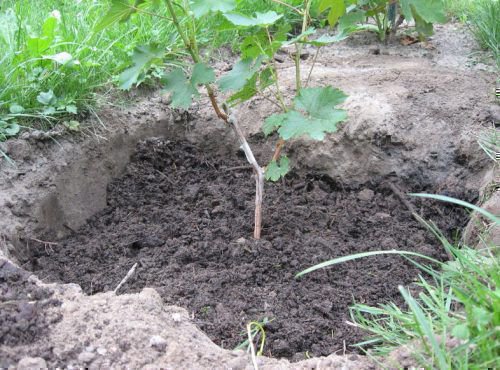

The pit for planting the variety of rolls must be large
Despite the high resistance to frost in the winter, especially in areas with a low level of snow cover, it is recommended to cover Valek with sawdust, spruce branches and mulch for the period of cold weather.
Since Valek is prone to overgrowth, when planting, it is especially necessary to carefully determine the boundaries of each bush.
The distance between plants, in optimal conditions, should be about 3 meters. This distance will allow not only to provide nutritious resources, but also to create optimal lighting conditions, which Valek "loves" very much. When planting in rows - the distance between each row should be about 4 meters. The procedure for planting and preparing a planting pit for Valek grapes does not differ in any significant requirements. It is recommended only to take into account the "love" of this variety for "space" and growth.
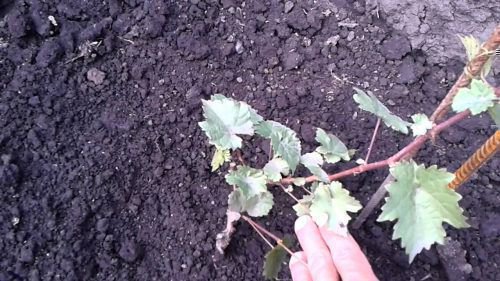

The soil must be well prepared and fertilized
For this reason, the pit is made as large as possible (at least 80 cm deep).
The abundant growth of the root system in all directions (in depth and width) makes the transplantation difficult. In addition, this feature of root development increases the requirements for the level of soil moisture. This variety should not be planted in a land with a high groundwater table, in lowlands with a high concentration of moisture in the soil, in swampy and shaded areas.
Read also: Pepper - Red shovel: characteristics and description of the variety, reviews, photos, who planted
The optimal soil for this grape variety is light loam with a small content of black soil.
In addition, Valek is "afraid" of cold winds and drafts, for this reason, planting along fences or buildings will be an advantage for development and growth.
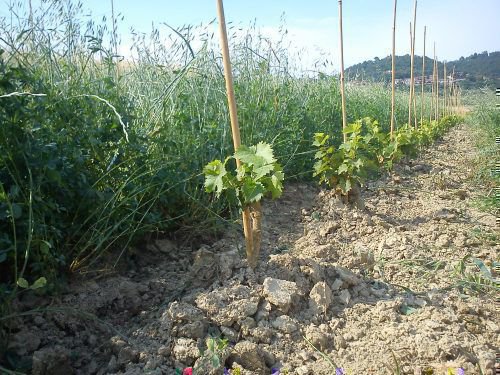

The site must be lit and protected from the winds
Based on the above recommendations for the cultivation of Valek grapes, you can draw up a list of requirements for choosing an area for planting it. The terrain must have the following characteristics:
- Well-lit open areas.
- Lack of shading or the prospect of future shading by other plants (be careful about planting other plants nearby, which, as they grow, can create inconvenience for lighting the bushes).
- Preferably areas on hills, with deep groundwater, moderate soil moisture. The lowland is dangerous due to the increased probability of "stagnation" of cold air and moisture.
- South or southwest side of the slopes.
- Areas protected from winds by natural barriers, fences or structures. There should be a harmony of space for lighting and plant growth, as well as the presence of barriers to natural troubles (winds, drafts).
- The soil should be selected light, well saturated with oxygen and perfectly permeable to excess moisture.
- It is necessary to water the grapes no more than 3 times a year; in dry periods, the intensity should be increased to 4-5 waterings.
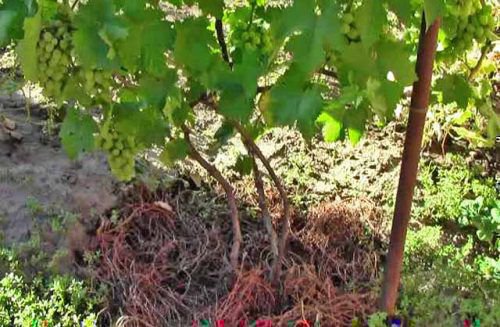

Mulching grapes retains moisture in the soil
Although Valek is not afraid of mildew, oidium and rot, as a preventive measure, it is worth taking measures to maintain the normal moisture regime of the soil (good drainage, in order to avoid the accumulation of moisture in certain areas).
Do not neglect measures to control weeds and various organic debris around the bushes.
As means of dealing with wasps, growers call the following measures:
- destruction of closely spaced hornets' nests;
- the use of special nets for bunches;
- use of special baits for wasps.
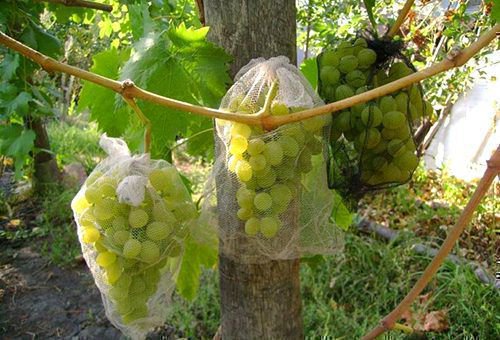

Protection against wasps with nets
Valek is popular and quickly spreads in horticultural areas due to its excellent "vitality" and resistance to transportation of cuttings. A novice grower can safely buy cuttings, even if it is known that they have "traveled" a sufficiently long distance. The main thing is that they are intact and healthy in appearance.
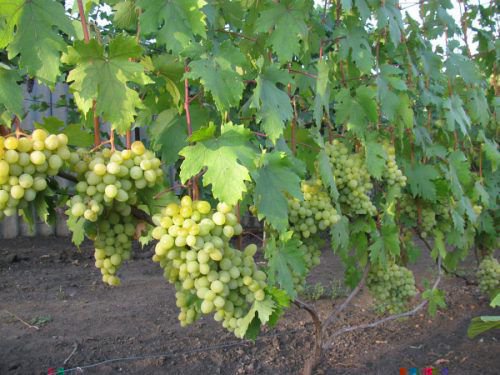

Harvest on the bush for 3 years
Since the fruit of the Valek grape is sensitive to the intake of nutrients, it is important to monitor the uniform and harmonious development of the bush. To do this, you need to periodically:
- Break off the shoots in the period after the formation of antennae and inflorescences and before their woodiness at the base. Such measures will allow to get rid of weak, damaged and unnecessary branches, to enable healthy shoots to receive the "released" nutrients.
- Pinching and breaking off stepchildren. Recommended for a couple of days before flowering.
- Thinning of foliage, removal of old, damaged leaves, as well as those that shade bunches and berries. But do not be too zealous with the removal, it is optimal to remove no more than 4-5 leaves from each bunch. Removing the leaves increases the likelihood of bird damage to the fruit, so the procedure should be carried out as carefully and balanced as possible.
- Carrying out autumn pruning after foliage has fallen.
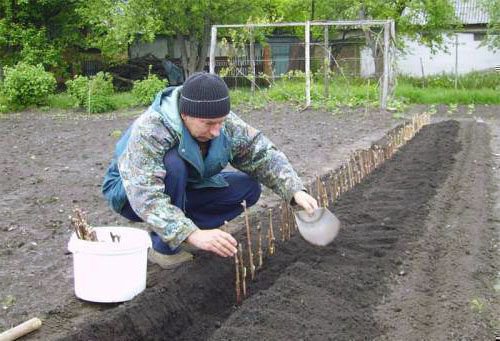

Valek is easily propagated by cuttings
As mentioned above, it is best to plant Valek grapes with seedlings, especially since you can easily purchase cuttings in specialized nurseries or from professional gardeners. In addition, with the proper level of knowledge, you can prepare cuttings yourself if you already have your own bush of this variety.
Valek grapes have the following characteristics:
- The bunches are distinguished by their high density, large size and large weight (1.5 - 2 kg). It is noted that the older the grape bush, the more weighty the bunches are. This grape adds weight to its harvest every year.
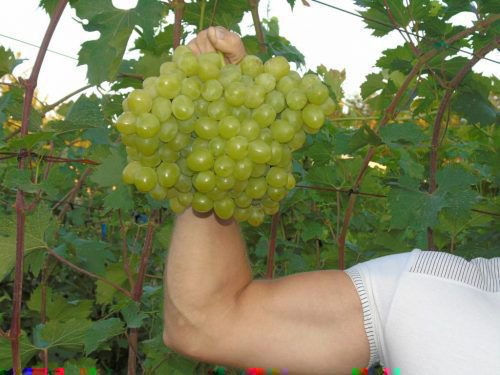

The bunches of Valek grapes are very large
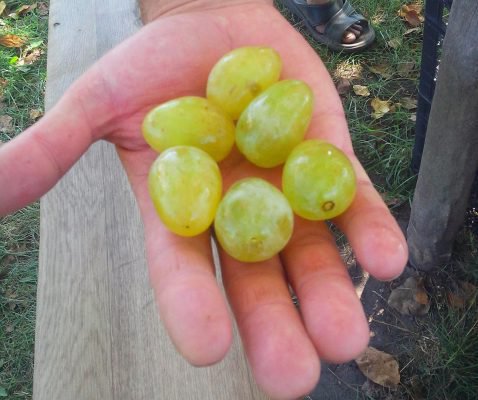

Valek berry is large and juicy
Bushes require regular and correct pruning of the vines to prevent peas. If these conditions are violated, the size of the berries decreases and the taste deteriorates (a sour taste appears). So you should not allow the development of even two bunches on one vine.
The berry of this white table grape is intended to be eaten fresh.
The density of grapes in bunches is often one of the main disadvantages of this grape variety. For this reason, Valek is not in demand and popularity among wholesale buyers. However, in practice, the density does not lead to crushing, cracking and subsequent spoilage of the berries.
Care features
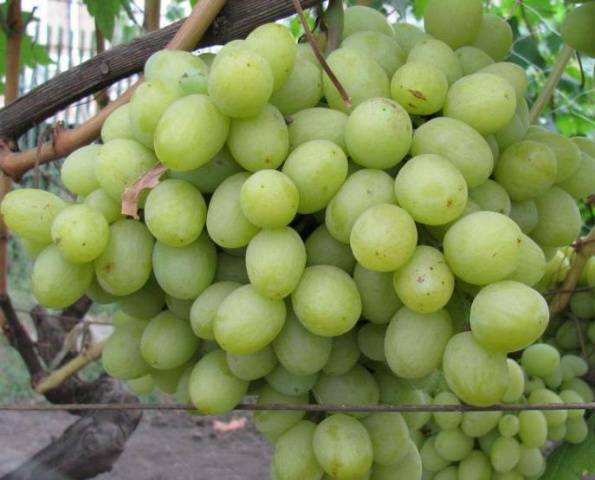

Considering the Valek grapes, the description of the variety, it is worth noting the photophilousness of the culture. Bushes develop only in a free area, not shaded by large trees. Proximity to any buildings is similarly oppressive to grapes.
On the site for seedlings, heights are chosen, especially if there is a high location of groundwater. It is optimal to choose the south side without drafts. Strong wind currents reduce the percentage of self-pollination of flowers, which affects a decrease in yield.
There are no special requirements for the composition of the soil in the Valek grape variety, but the bush grows better on light soil. The fertility of the land is increased by the introduction of fertilizing during planting of the seedling and throughout the entire period of the life of the culture.
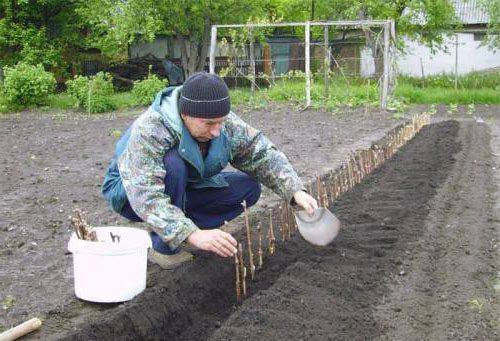

The mature Valek grape bushes are vigorous. When planting seedlings, keep a distance of at least 3 m. On large plantations, a minimum row spacing of 4 m is observed. Free space is required not only for the growth of vines. The horse system also needs to develop and receive a full portion of nutrients.
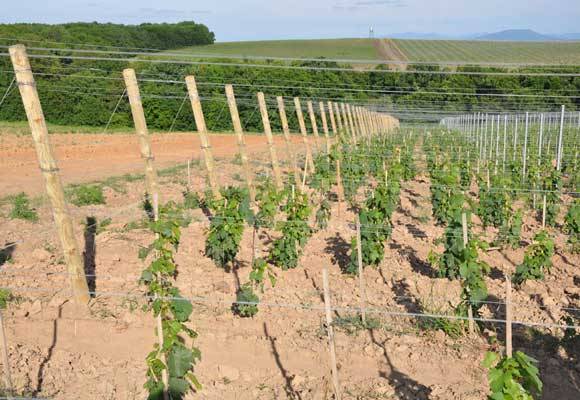

The breeding season for grapes begins in the third decade of March and ends in November.The time for planting planting material and the method of propagation are determined individually. Vaccinations, as well as planting dormant seedlings, are carried out in early spring. With the establishment of constant heat in late spring, grapes with open leaves and green shoots are planted. At the beginning of summer, you can also plant green seedlings, but this time is better suited for propagation by branches.
In the fall, planting seedlings should not be delayed, especially in cold regions. The grapes should have already entered the winter calm stage, but still have the ability to root. The optimal time for autumn planting is mid-October. In grapes, sap flow is already suspended, but before the onset of frost, the seedling will have time to take root and stock up on nutrients.
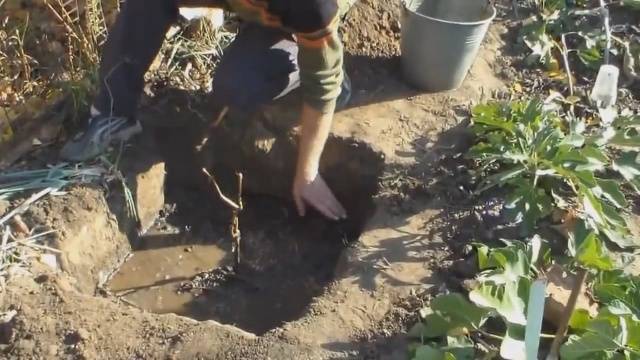

Good rooting and development of the bush depends on a properly prepared hole. It is important to initially lay in nutrients that will be enough for the seedling for the first years of life. A hole is dug with a depth of at least 80 cm.The shape can be round or square, but the hole is also made up to 80 cm wide.
At the bottom of the hole, a drainage layer with a thickness of about 20 cm is laid out of stones and sand.If there is loose sandy soil on the site, then drainage can be abandoned. For further backfilling, a nutrient mixture is prepared. Chernozem is mixed in equal amounts with humus or compost, dry granules of mineral fertilizer are added. Superphosphate and potassium are commonly used. The hole is filled with a nutrient mixture so that a depth of about 50 cm remains for planting a seedling.
Important! The pit is prepared in autumn or spring three weeks before the planting of Valek grapes. Before planting a seedling from chernozem, a mound is formed at the bottom of the hole.
When buying a seedling of Valek grapes, its appearance is carefully examined. The root must be more than 10 cm long without dry branches. Aboveground part without crust damage and with at least four developed kidneys.
Before planting, the seedling is immersed in water for a couple of hours. You can add a root growth stimulant. The seedling is lowered into the hole with the heel on a mound, and the roots are spread along the slopes. The aboveground part is turned by the kidneys to the north. The root heel faces south. The seedling is carefully covered with loose soil, without burying it above the level of the root collar. After dusting, up to three buckets of water are poured into the hole. After absorbing the liquid, the soil is poured to the desired level, and mulch is poured on top.
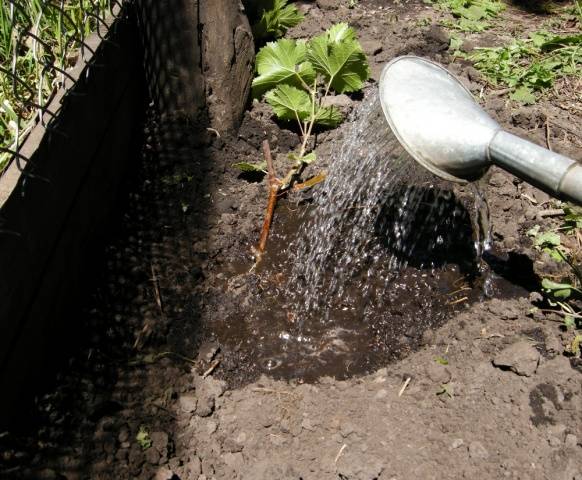

Further care for Valek grapes includes watering, feeding, weeding, pruning the vine, spraying with fungicides.
Water the Valek grapes as the soil dries up and always before flowering, during the ovary of berries, as well as in late autumn. The soil is constantly loosened, weeds are weeded, mulch is poured from sawdust or peat.
Top dressing with mineral complexes depends on the condition of the soil, and organic matter is in demand every season. The bushes are poured with a solution of bird droppings, sprinkled with dry rotted manure or compost instead of mulch.
For preventive spraying, fungicides are used. Colloidal sulfur and Bordeaux liquid show good results in the fight against fungus.
Pros and cons of Valek grapes
Based on the above data, which thoroughly characterize this variety, we can conclude that it has a large number of advantages, and its disadvantages are minimal.
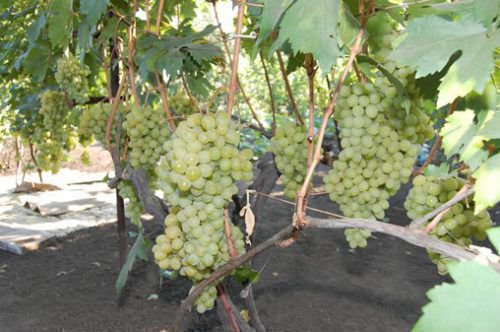

The yield of Valek grapes is very high
Valek is recommended for winegrowers as a stable and healthy grape with a large, high-quality and tasty harvest.
The main advantages of this variety are the following features:
- High survival rate, resistance to frost and disease.
- Excellent yield indicators.
- Delicious, sweet, large and firm berries and bunches. Long shelf life. Very attractive aesthetic appearance of bunches and berries.
- High percentage of pollination.
- Short ripening period.
The disadvantages of Valek grapes include:
- Capriciousness to the quality of the soil.
- Sensitive to moisture.
- Demanding for large spaces.It is critical in the limited spaces of suburban and suburban areas of many grape-growing lovers.
Biological description
It is not only the taste that attracts gardeners, but also the appearance of the vine. Valek is one of the most beautiful hybrids that will decorate the site.
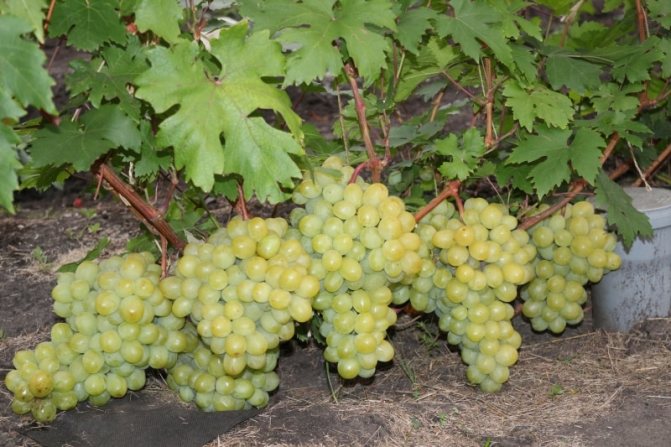

Bushes and shoots
The bushes of the Valek vine are vigorous, strong, not afraid of gusts of wind. Shoots are highly developed and grow rapidly. The young vine has time to fully ripen during the summer. If you do not prune in time, the bush can grow quite wide in width.
Berries and bunches
Huge cone-shaped clusters are one of the main advantages of the hybrid. Despite the high density of the brush, the berries are not damaged, they have time to ripen over the summer and do not crack even in a rainy summer.
Distinctive characteristics of the variety
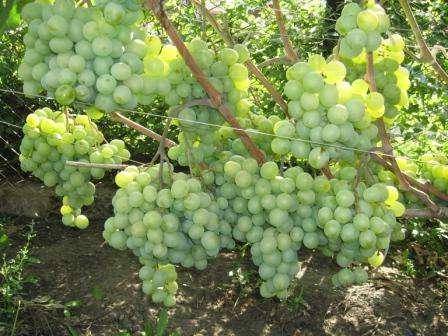

To breed a hybrid form, varieties with a good pedigree were taken: "Kesha 1", "Zvezdny", and "Rizamat". When three parents were crossed, an excellent grape was obtained, the berries of which are intended for fresh consumption. Initially, the variety was zoned for northern Ukraine, but the grapes adapt well to different weather conditions.
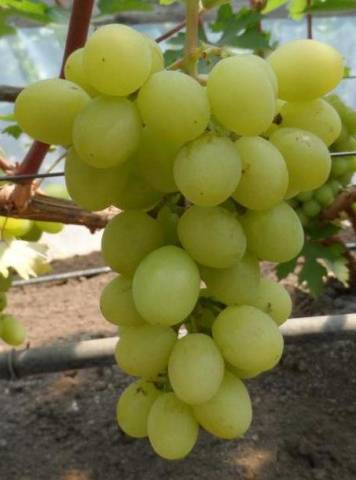

Consider Valek grapes, a description of the variety, photos, reviews should start with an overview of the brushes. Huge bunches weighing 1.5–2.5 kg are the main advantage of the hybrid. In terms of large fruit size, Valek confidently competes with popular high-yielding varieties. The clusters are formed with a tight fit of the berries.
The oval-shaped berries are elongated up to 3 cm in length, and the width reaches 2.8 cm. The weight of one fruit is about 14 g. The color of the berries is green. When fully ripe, the pulp with the skin turns yellow to amber. In the sun, the barrels are slightly browned.
The taste of Valek grapes is sweet. The aroma is reminiscent of a mixture of nutmeg and pear. The pulp is tender, fleshy, resistant to cracking due to the thick skin, but when eaten it is poorly felt.
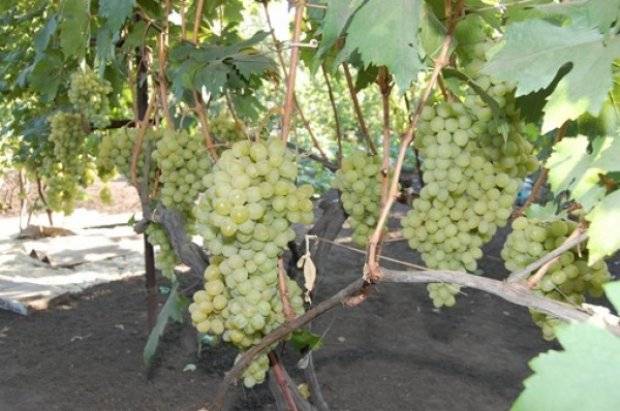

Good fruiting cannot occur without strong vine growth. Valek grape bushes are spreading, characterized by intensive vine growth. The shoots have time to ripen during the season. Discarding bisexual flowers increases the percentage of self-pollination. The color lasts for about 10 days. Pollination will occur even in rainy summers without the participation of bees.
Read also: Video of processing tomatoes with phytosporin - preparing a solution and spraying tomatoes
In terms of ripening, the Valek variety is considered an early grape. The first bunches can be picked in the first decade of August. It usually takes 105 days from awakening the buds to harvesting. In southern Ukraine, the bunches of the Valek hybrid ripen earlier than the popular early Arcadia variety.
Description
Valek ripens rather quickly, in just 105 days. Harvesting is possible in July, and for the northern regions this period begins in mid-August. The vine of this variety grows quite strongly. Bunches of grapes by weight can reach up to 1.8 kg.
The main characteristics of the description of the berries of the Valyok variety:
- Have a regular, round shape;
- The color of the ripe fruit is bright yellow;
- The berries have a pear flavor, moderately sweet and nutmeg aroma;
- The berry is rather large and fleshy;
- Contains 17-18% sugar;
- The berry can grow up to 3 cm in length, and about 2.5 in width;
- The weight of one berry can vary from 9 grams to 17 grams;
- The peel of the berry can also be eaten, it is not hard and has a pleasant sweet taste;
- During transportation, the berries do not wrinkle and do not fall off the branch.
Positive and negative qualities
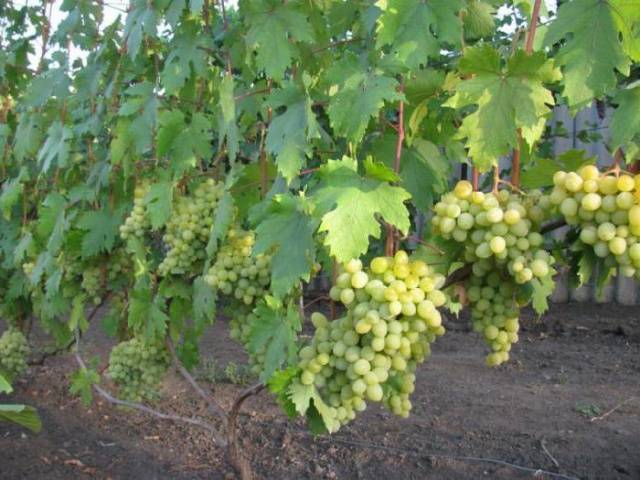

Reviewing the description of the Valek grape variety, photos, reviews, videos, as a summary, we will consider the positive and negative features of the culture. Among the advantages are:
- original taste that is not inherent in other varieties;
- high yield, stable fruiting, large brushes and fruits;
- good presentation of the bunches;
- early maturation;
- bisexual flowers are able to pollinate neighboring bushes, not without the participation of bees;
- there is no pea berries in the tassels;
- the Valek grape harvest lends itself to transportation and storage;
- resistance to fungal diseases;
- the vine winters well, even if it has undergone hypothermia to a temperature of -24 o C.
Valek is bred from three of the best grape varieties, in which it is difficult to find negative traits. The downside is the poor compatibility of the rootstock with the scion. It is better to propagate Valek grapes by cuttings on their own roots than to be grafted.
On the video you can get acquainted with the Valek variety:
Useful properties and application
The calorie indicators of the variety are pleasing - only 45 kcal per 100 grams of the product. However, you should not abuse grapes: a large amount of eaten berries can provoke bloating, exacerbation of peptic ulcer and kidney problems, and a jump in blood sugar.
Regular eating of berries can be recommended to everyone who strives to strengthen their immunity, improve the functioning of the nervous system, increase the level of hemoglobin, improve the condition of the skin, and strengthen the walls of blood vessels.
Its main purpose is fresh consumption. You can also cook jam, compotes from berries, add to desserts and pastries. Thanks to their dense consistency and strong peel, they can be marinated and soaked, preparing excellent snacks for the winter.
Breeding options
There are many ways to propagate the Valek grape variety. The grower chooses the most affordable and easy option for himself. It is best to purchase seedlings or grow them from cuttings, but other methods can be used.
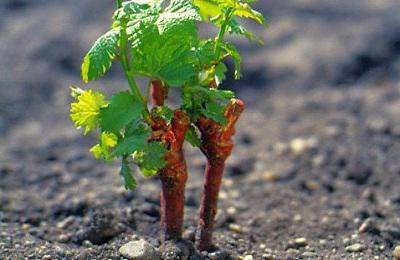

For propagation of Valek grapes, the following methods are used:
- Growing on your own roots. For the Valek variety, this is the most effective breeding method, given that the crop is a hybrid. The seedling is bought in the nursery or at the market. If the neighbors have an adult Valek grape bush on the site, then in the fall you can ask for a cutting. In the spring, a piece of vines is planted in a flower pot, and an excellent seedling is obtained from it.
- Reproduction by grafting allows you to get a quick increase. However, Valek is poorly compatible with other varieties. For the sake of interest, you can try to plant a couple of cuttings or buds on another bush, but you should not hope for such a method of reproduction.
- Reproduction by branches for the Valek variety is also acceptable, since the new seedling will grow on its own root. The method is based on digging in a section of a mature vine without cutting the lash from the bush. Over time, in damp soil, the cuttings will take root. Now it can be cut from the bush with a pruner and transplanted for further rooting.
There is a variant of grape seed propagation. The method is suitable if it was not possible to get seedlings or cuttings. Large ripe seeds are removed from the berries of the purchased bunch and planted in the ground. After 2 years, an excellent seedling is obtained. However, for hybrid varieties, the seed option is poorly suited. Grapes can only grow with the characteristics of a single parent.
Care Tips
Valyok, a white table grape variety, is considered unpretentious and produces yields in different conditions. To get a good harvest, you need to properly care for it.
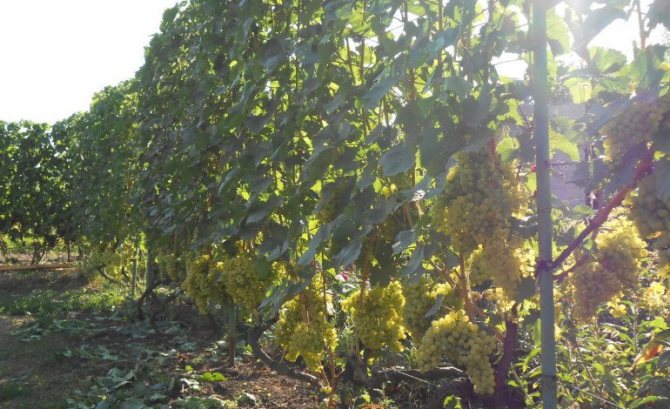

Watering
Valyok grapes are unpretentious in watering: for the whole year it is enough to water it abundantly 3 times. Watering is carried out before flowering, and then during the period of fruit formation. If the weather is too dry, irrigation should be carried out unscheduled. Watering should be done at the root - moisture on the foliage can cause sunburn. Pour at least two buckets of water under each bush.
Support and garter shoots
Usually, the garter is carried out twice - in the spring, after removing the shelter for the winter, and in the summer, when the shoots are growing. After the shoots reach 40–50 cm, it is time for a green garter, which is necessary for protection from wind gusts and for better pollination.
Important! In the spring, the garter should be done before the formation of the kidneys so as not to damage them during the procedure.
For this purpose, the following materials are used:
- old nylon tights;
- rags, soft in structure;
- special ribbons that can be purchased at a garden store.
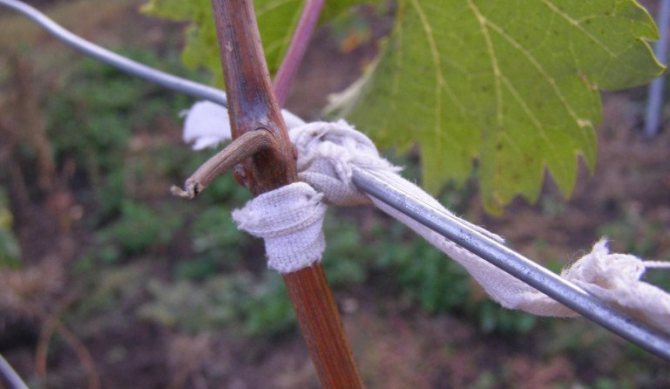

Young grape seedlings have enough pegs for a garter. But for adult bushes of grapes, you need to install trellises. To install them, pillars (made of wood or metal) are dug in with a height of about 2.6-3 meters, 12-15 cm thick, at a distance of about 3 meters from each other. Between the pillars, a wire is pulled in three rows, to which the vine is tied.
Top dressing
It is necessary to feed the grapes, which coincides with the watering time.

